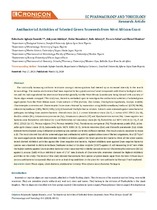| dc.description.abstract | The continually increasing antibiotic resistance amongst microorganisms had steered up an increased intensity in the search
for new drugs. The marine environment had been reported to be a great source of novel compounds with diverse biological activities
and this had engendered the attention of researcher globally, but the West African Coast despite being blessed with a variety of
Macro-algae remain untapped. This study was, therefore, embarked upon to investigate the antibacterial activities of selected green
algal species from the West African coast. Crude extracts of Ulva fasciata, Ulva lactuca, Chladophora vagabunda, Caulepa taxifolia,
Chaetomorpha antennina and Chaetomorpha linum were obtained by maceration using Dichloromethane/methanol (DCM/MeOH),
chloroform/methanol (CHL/MeOH) 90% (v/v), Ethanol and Diethyl ether as solvents. Extracts were screened against some bacterial
pathogens including Gram-positive bacteria- clinical strain (Sa I), S. aureus laboratory strain (Sa II), S. aureus ATCC 25922 (Sa III),
Bacillus subtilis (Bs), Streptococcus pneumonia (Sp), Streptococcus faecalis (Sf) and Mycobacterium aurum (Ma). Gram-negative test
bacteria were Escherichia coli clinical (Ec I) and Escherichia coli laboratory strain (Ec II), Escherichia coli NCTC 10418 (Ec III), E. coli
ATCC 25923 (Ec IV), Proteus vulgaris (Pv), Proteus mirabilis (Pm), Pseudomonas aeruginosa (Pa) Pseudomonas putida (Pp), Salmonella
typhi clinical strain (St I), Salmonella typhi NCTC 8385 (St II), Serratia macerans (Sm) and Klebsiella pneumonia (Kp). Crude
extracts were obtained using Antibacterial screening was carried out by disc diffusion method. The result analysis was done by mean
± SD. The result showed that all the screened algae had antibacterial activity against at least one of the test organisms. Four (57%) of
the seven algal species tested demonstrated inhibitory activities against the Gram-positive test bacteria while all the seven species
tested showed inhibitory activities against the Gram-negative test bacteria. Highest inhibitory zone against Gram-negative bacterial
species was observed in dichloromethane/methanol extract of Caulepa taxifolia (DCCT) against E. coli measuring 14.67 mm while
the highest activity against Gram-positive bacterial strain was observed in diethyl acetate extract of Chaetomorpha antennina (DECA)
against S. aureus (SaII) with an inhibitory zone of 17.67 mm. Extracts of Chaetomorpha antennina showed the highest inhibitory
activities in this study. The result of this study showed that extracts from species of green macro-algae from the West African Coast
possess antibacterial compounds that can serve as lead drug candidates in the quest for new antibacterial therapy if well explored. | en_US |

